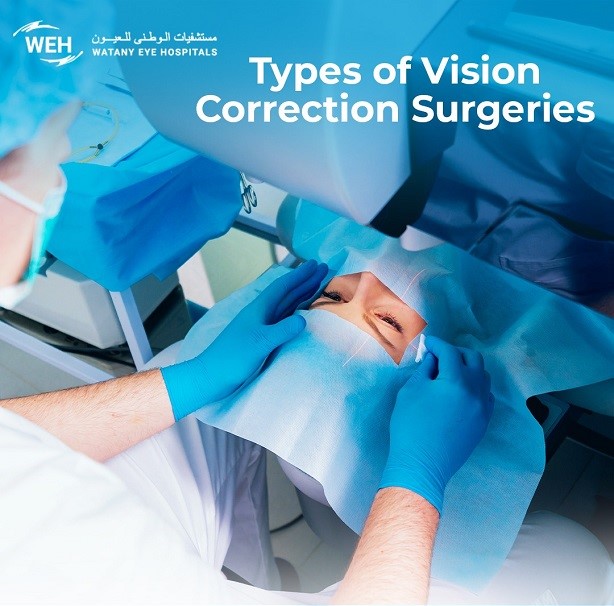
LASIK, Femto LASIK, and Femto SMILE:
Understanding the Differences
LASIK, Femto LASIK, and Femto SMILE are all laser vision correction procedures (refractive surgery) that can help people with refractive errors such as nearsightedness (myopia), farsightedness (hyperopia), and astigmatism achieve clear vision without glasses or contact lenses.
However, there are some key differences between these procedures that you should consider before making a decision.
1- LASIK
Traditional LASIK is the most common type of laser vision correction surgery. In LASIK, a thin flap is created in the cornea using a microkeratome. The flap is then lifted back, and an excimer laser is used to reshape the underlying corneal tissue to correct the refractive error. The flap is then replaced and allowed to heal naturally.
This technique can help people with nearsightedness, farsightedness and astigmatism.
Advantages of LASIK:
• Fast and effective procedure
• Safe and effective results
• Can correct a wide range of refractive errors
Disadvantages of LASIK:
• LASIK surgery can temporarily cause dry eyes, but this usually improves gradually with the use of lubricating eye drops recommended by your doctor after the procedure.
2- Femto LASIK
Femto LASIK is a type of LASIK that uses a femtosecond laser to create the corneal flap instead of a microkeratome. This creates a more precise and customized flap, which can lead to better visual outcomes and a reduced risk of complications.
Advantages of Femto LASIK:
• More precise flap creation
• Reduced risk of complications
• Faster healing time
Disadvantages of LASIK:
• More expensive than traditional LASIK
• Similar to the traditional LASIK, Femto LASIK can temporarily cause dry eyes, but this usually improves gradually with the use of lubricating eye drops recommended by your doctor after the procedure
3- Femto SMILE
Femto SMILE is the most recent advancement in laser vision correction. In Femto SMILE, a femtosecond laser is used to create a small lenticule inside the cornea, which is then removed through a tiny incision. The cornea is then reshaped to correct the refractive error.
Advantages of Femto SMILE:
• Minimally invasive procedure
• Preserves more corneal tissue
• Faster healing time
• Reduced risk of dry eyes
Disadvantages of Femto SMILE:
• Not suitable for all refractive errors
• More expensive than LASIK and Femto LASIK
Choosing the Right Vision Correction Technique:
Choosing the appropriate vision correction technique depends on several factors, the most important of which are:
Type of vision defect:
• LASIK and Femto-LASIK are suitable for treating myopia, hyperopia, and astigmatism.
• Femto-SMILE is suitable for treating myopia only.
Corneal thickness:
• Femto-SMILE is preferred for those with thin corneas.
Here are some frequently asked questions about LASIK vision correction:
How do I know which type of LASIK is suitable for my eyes?
Before undergoing laser vision correction, the doctor will perform a comprehensive examination of your eyes to assess their health and determine your suitability for the procedure. This examination includes:
• Measuring corneal thickness.
• Measuring the size of the pupil.
• Evaluating the overall health of the eye.
• Performing tests to image the surface and thickness of the cornea to assess its suitability for the procedure.
Based on the results, the doctor will decide the most suitable type of LASIK for your condition, whether it's traditional LASIK, Femto-LASIK, or Femto-SMILE.
Should I stop wearing contact lenses before undergoing LASIK?
Yes, you should stop using contact lenses at least a week before the first examination and at least two weeks before the procedure. This duration may vary for hard lenses, so consult your ophthalmologist for specific instructions.
Will my vision deteriorate again after LASIK?
In general, vision does not deteriorate after LASIK. Most patients enjoy stable vision for many years after the procedure.
those with thin corneas.
Here are some instructions you should follow after your LASIK procedure:
• Use the prescribed eye drops as directed by your doctor.
• Wear sunglasses that block harmful UV rays to protect your eyes from sunlight, especially during the first few weeks after the procedure.
• Avoid rubbing your eyes.
• It is important to regularly visit your doctor after the procedure to ensure proper healing. Your doctor will set a follow-up schedule based on your needs.
• Avoid using cosmetics around the eyes during the first few weeks after the procedure.
• Follow your doctor's instructions on when you can resume normal daily activities, such as driving and sports.
• Your vision will gradually improve in the days following the procedure. It may take some time for your vision to stabilize completely.
Watany Eye Hospitals Advice for You:
With modern vision correction techniques, you can get rid of glasses and contact lenses and enjoy clear vision and a happy life. It is important to consult your doctor to assess your condition and determine the appropriate vision correction technique for you. The doctor will help you understand all available options and answer all your questions.